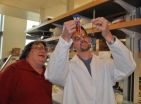(Press-News.org) (Santa Barbara, Calif.) –– Scientists can use cylinders as small as teapots to study the mechanisms involved in powerful hurricanes and other swirling natural phenomena.
The earth's atmosphere and its molten outer core have one thing in common: Both contain powerful, swirling vortices. While in the atmosphere these vortices include cyclones and hurricanes, in the outer core they are essential for the formation of the earth's magnetic field. These phenomena in earth's interior and its atmosphere are both governed by the same natural mechanisms, according to experimental physicists at UC Santa Barbara working with a computation team in the Netherlands.
Using laboratory cylinders from 4 to 40 inches high, the team studied these underlying physical processes. The results are published in the journal Physical Review Letters.
"To study the atmosphere would be too complicated for our purposes," said Guenter Ahlers, senior author and professor of physics at UCSB. "Physicists like to take one ingredient of a complicated situation and study it in a quantitative way under ideal conditions." The research team, including first author Stephan Weiss, a postdoctoral fellow at UCSB, filled the laboratory cylinders with water, and heated the water from below and cooled it from above.
Due to that temperature difference, the warm fluid at the bottom plate rose, while the cold fluid at the top sank –– a phenomenon known as convection. In addition, the whole cylinder was rotated around its own axis; this had a strong influence on how the water flowed inside the cylinder. Rotation, such as the earth's rotation, is a key factor in the development of vortices. The temperature difference between the top and the bottom of the cylinder is another causal factor since it drives the flow in the first place. Finally, the relation of the diameter of the cylinder to the height is also significant.
Ahlers and his team discovered a new unexpected phenomenon that was not known before for turbulent flows like this. When spinning the container slowly enough, no vortices occurred at first. But, at a certain critical rotation speed, the flow structure changed. Vortices then occurred inside the flow and the warm fluid was transported faster from the bottom to the top than at lower rotation rates. "It is remarkable that this point exists," Ahlers said. "You must rotate at a certain speed to get to this critical point."
The rotation rate at which the first vortices appeared depended on the relation between the diameter and the height of the cylinder. For wide cylinders that are not very high, this transition appeared at relatively low rotation rates, while for narrow but high cylinders, the cylinder had to rotate relatively fast in order to produce vortices. Further, it was found that vortices do not exist very close to the sidewall of the cylinder. Instead they always stayed a certain distance away from it. That characteristic distance is called the "healing length."
"You can't go from nothing to something quickly," said Ahlers. "The change must occur over a characteristic length. We found that when you slow down to a smaller rotation rate, the healing length increases."
The authors showed that their experimental findings are in keeping with a theoretical model similar to the one first developed by Vitaly Lazarevich Ginzburg and Lev Landau in the theory of superconductivity. That same model is also applicable to other areas of physics such as pattern formation and critical phenomena. The model explains that the very existence of the transition from the state without vortices to the one with them is due to the presence of the sidewalls of the container. For a sample so wide (relative to its height) that the walls become unimportant, the vortices would start to form even for very slow rotation. The model makes it possible to describe the experimental discoveries, reported in the article, in precise mathematical language.
INFORMATION:
The other UCSB author is postdoctoral fellow Jin-Qiang Zhong. Additional authors are Richard J. A. M. Stevens and Detlef Lohse from the University of Twente and Herman J. H. Clercx from Eindhoven University of Science and Technology, both in the Netherlands.
Tempest in a teapot: International team of scientists describes swirling natural phenomena
2010-11-30
ELSE PRESS RELEASES FROM THIS DATE:
Hormone oxytocin bolsters childhood memories of mom's affections
2010-11-30
Researchers have found that the naturally-occurring hormone and neurotransmitter oxytocin intensifies men's memories of their mother's affections during childhood. The study was published today in Proceedings of the National Academy of Sciences.
Researchers at the Seaver Autism Center for Research and Treatment at Mount Sinai School of Medicine wanted to determine whether oxytocin, a hormone and neurotransmitter that is known to regulate attachment and social memory in animals, is also involved in human attachment memories. They conducted a randomized, double-blind, ...
Caffeinated alcoholic beverages -- a growing public health problem
2010-11-30
San Diego, CA, November 30, 2010 – In the wake of multiple state bans on caffeinated alcoholic beverages (CABs) and an FDA warning to four companies to remove their products from the marketplace, an article published online today in the American Journal of Preventive Medicine delineates the scope of the public health problem and suggests areas of research that might help address it.
"Although several manufacturers of caffeinated beer have withdrawn their products from the market, there is no sign that young people have decreased the practice of combining alcohol and energy ...
Neuroscience of instinct: How animals overcome fear to obtain food
2010-11-30
When crossing a street, we look to the left and right for cars and stay put on the sidewalk if we see a car close enough and traveling fast enough to hit us before we're able to reach the other side. It's an almost automatic decision, as though we instinctively know how to keep ourselves safe.
Now neuroscientists have found that other animals are capable of making similar instinctive safety decisions. In a study published online the week of Nov. 29 in the Proceedings of the National Academy of Sciences, University of Washington researcher Jeansok Kim demonstrates that ...
Motivation to end racism relies on 'yes we can' approach
2010-11-30
If you're trying to end racism, it's not enough to get people to understand that racism is still a problem. You also have to make them feel like they can do something about it, according to a new study published in Psychological Science, a journal of the Association for Psychological Science.
Tracie L. Stewart of Georgia State University was inspired to conduct the study by work she's done on evaluating a popular diversity training program. She found that the program reduced many white participants' bias in the short term, which was good. "But some white participants ...
Abnormal blood vessel function found in women with broken heart syndrome
2010-11-30
ROCHESTER, Minn. - A team of Mayo Clinic researchers has found that patients with broken heart syndrome, also known as apical ballooning syndrome (ABS), have blood vessels that don't react normally to stress. These results offer clues to the cause of this rare syndrome and may help with efforts to identify patients who are more vulnerable to mental stress so that appropriate therapies can be developed. The study is published online in the Journal of the American College of Cardiology.
Apical ballooning syndrome affects mainly postmenopausal women, and a few men. The symptoms ...
Study: Avoidance, poor coping challenge prisoners returning to society
2010-11-30
How do individuals often cope with reentry from prison to society?
Too frequently with avoidance, says Lindsay Phillips, assistant professor of psychology at Albright College in Reading, Pa. and author of the forthcoming paper, "Prison to Society: A Mixed Methods Analysis of Coping with Reentry," to be published by the International Journal of Offender Therapy and Comparative Criminology.
"There is a defined process experienced by participants, which is initial optimism about release, followed by craving substances, facing practical barriers, or feeling overwhelmed," ...
How authentic is your pomegranate juice?
2010-11-30
RIVERSIDE, Calif. – You pick up a bottle of pomegranate juice at the store because you've learned that, although it costs more than most juices, it is replete with antioxidants that bring health benefits. But wait: Is the juice you've purchased really pomegranate juice? Or is the product label you have carefully read promising more than it delivers?
A chemist at the University of California, Riverside is determined to find out. Cynthia Larive, a professor of chemistry, is playing detective by applying chemical tests to juice products sold as pomegranate juice or pomegranate ...
Evolutionary psychology: Why daughters don't call their dads
2010-11-30
CORAL GABLES, FL (December 7, 2010)— Previous research has shown that when women are in their most fertile phase they become more attracted to certain qualities such as manly faces, masculine voices and competitive abilities. A new study by University of Miami (UM) Psychologist Debra Lieberman and her collaborators offers new insight into female sexuality by showing that women also avoid certain traits when they are fertile.
The new study shows that women avoid their fathers during periods of peak fertility. The findings are included in a study entitled "Kin Affiliation ...
U of I scientists develop tool to trace metabolism of cancer-fighting tomato compounds
2010-11-30
URBANA – The University of Illinois scientists who linked eating tomatoes with a reduced risk of prostate cancer have developed a tool that will help them trace the metabolism of tomato carotenoids in the human body. And they've secured funding from the National Institutes of Health to do it.
"Scientists believe that carotenoids—the pigments that give the red, yellow, and orange colors to some fruits and vegetables—provide the cancer-preventive benefits in tomatoes, but we don't know exactly how it happens," said John W. Erdman, a U of I professor of human nutrition.
The ...
Moderate alcohol consumption lowers the risk of metabolic diseases
2010-11-30
With the emergence of an epidemic of obesity and type 2 diabetes (DM) throughout the world, the association of lifestyle habits that may affect the risk of metabolic diseases is especially important. Most prospective studies have shown that moderate drinkers tend to have about 30% lower risk of developing late onset diabetes than do non-drinkers, and moderate drinkers also tend to be at lower risk of developing metabolic syndrome (MS). A cross-sectional analysis of 6172 subjects age 35 -75 in Switzerland related varying levels of alcohol intake to the presence of DM, ...


